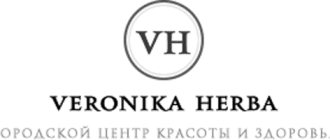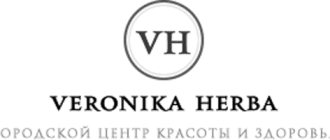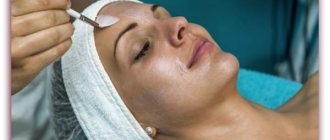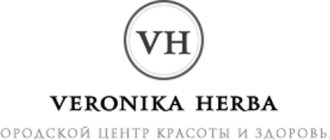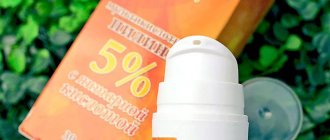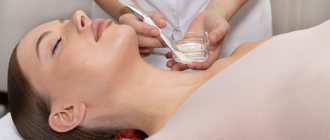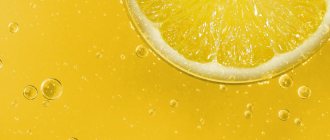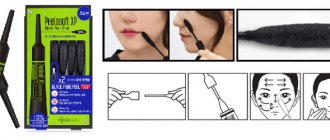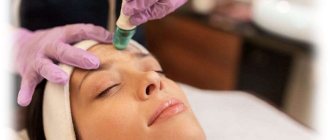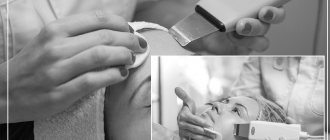From this article you will learn:
- Features of the facial peeling procedure
- Types of peelings for facial skin
- Chemical peeling for face
- Mechanical facial peeling
- Ultrasonic facial peeling
- Laser facial peeling
- Choosing the type of facial peeling based on age and skin type
Despite the large number of types of facial peels in cosmetology, they have similar tasks. Each helps cleanse and rejuvenate the skin. Depending on the depth of penetration, the substances included in the peels remove dead cells, stimulating regeneration.
The effectiveness of the procedure is also determined by the method of exposure. Some peels mechanically remove dead skin cells, while others dissolve them chemically. We will talk about the intricacies of using various types of peelings for the face and décolleté in this article.
Features of the facial peeling procedure
Translated from English, the word “peeling” means “to wash”, “to clean”. Therefore, this event is intended to deeply cleanse the facial skin, remove sebum and impurities, and eliminate dead cells from the surface of the skin.
After exfoliation of the stratum corneum, a renewed, fresh layer of epidermis appears. Young skin better absorbs oxygen and moisture, which normalizes metabolic processes, increases resistance to external negative factors, and improves cell nutrition.
There is an opinion that peeling is just a rejuvenating procedure. However, there are different types of facial peels that have their own characteristics. The basis for its implementation depends on the specifics of a particular procedure. General indications include:
- sagging and sagging skin;
- excessive pigmentation;
- the presence of a thick keratinized upper layer of the epidermis;
- consequences of acne.
Thanks to cleansing, age-related changes become less pronounced. Skin regeneration helps reduce deep or expression wrinkles. Peeling allows you to restore the structure of the skin layer, eliminating defects (microscars, age spots, various scars). In addition, during the procedure, the sebaceous glands and pores are cleansed, it serves as a prevention of inflammatory processes and acne.
Cleaning is not contraindicated for any skin type (dry, normal, oily).
Peeling is a fairly traumatic procedure, so it has a number of limitations:
- overly sensitive skin;
- presence of damage (wounds and abrasions on the face);
- age less than 18 years;
- acute stage of acne or herpes infection;
- pregnancy, lactation;
- tendency to allergies.
Peeling allows you to eliminate various defects and helps maintain healthy, fresh skin. The necessary conditions are the supervision of a professional and the implementation of all recommendations.
What cosmetologists have: name and description of all types of professional procedures
Modern beauty salons offer a number of ways to solve skin problems. They all have their pros and cons. Next, we will consider what the best of them actually are, and present a classification of the most popular and effective ones.
By depth of influence
To understand the specifics of how different types of peelings work on the skin, it is necessary to remember the structural features of the human skin. It consists of three layers: epidermis, dermis and hypodermis.
Depending on the depth of influence of physical factors or active substances, the following types of procedures are distinguished:
- With the superficial method, the effect on the skin is limited to the level of the stratum corneum. The active ingredients are fruit acids. This type of peeling does not cause pain. The technique is used to cleanse the skin, giving it smoothness and freshness. As a rule, it is used in combination, improving the penetration of active substances from cosmetic products deep into the skin.
- Medium professional peeling is more aggressive. The main active ingredients are TCA, azelaic and salicylic acids, and retinol. The procedure involves active peeling of the skin, which lasts about a week and is rarely accompanied by pain. The patient will notice the effect immediately after the first session. If there are no deep wrinkles or scars on the face, a repeat session is not required.
- Deep peeling is considered the most serious of all peeling procedures. During treatment, it acts on the epidermis and dermis up to the middle of the reticular layer. Removing the entire epidermal layer using phenol is a risk to human health.
We recommend: An effective procedure for cleansing and rejuvenation - chemical peeling: types, stages, results.
Medium and deep types, which are the most effective, are very painful for the patient, and it is difficult to say which one is better to do, since controlled tissue damage occurs. Due to this, the regeneration process starts, the skin becomes softer, and any unevenness is smoothed out.
Important! The deep effect of peeling implies a longer recovery period and a more pronounced aesthetic effect.
Mechanical
The essence of this type of procedure is to speed up the exfoliation process and enhance microcirculation. Mechanical peeling is superficial in nature, since only the top layer of cells is removed. The safest methods are scrub and gommage.
A scrub is a cosmetic product that contains a variety of abrasive particles - synthetic or natural, coarse and finely ground. The action depends on them - tough or delicate. The following are used as abrasives:
- sugar crystals;
- sea salt;
- crushed apricot kernels;
- nutshell;
- as well as polyethylene granules.
Gommage is produced in paste form. In other words, this is a cream of dense consistency based on plant extracts, which does not contain abrasive particles.
The peculiarity of gommage is that it is applied to the face in a thick layer, and after hardening, it is rolled up with the fingers together with the softened keratinized scales.
Chemical
Manufacturers use a variety of acids as the basis for their compositions, for example, glycolic, lactic, and salicylic. Once on the surface of the skin, the active substances dissolve the bonds between keratinized scales and promote renewal.
Each acid in the formula is aimed at combating specific skin imperfections. During the procedure, she experiences stress, due to which protective functions begin to work more actively. A weak solution of acids evenly cleanses dead cells and stimulates the synthesis of collagen and elastin. The result is skin rejuvenation, increased tone and elasticity.
Ultrasonic
This is the name of a type of hardware surface cleaning procedure. Thanks to the influence of ultrasonic waves, the keratinized layer of cells is removed from the surface of the facial skin, facial wrinkles and unevenness are smoothed out, blood circulation improves, due to which the skin is moisturized naturally. Ultrasonic peeling:
We recommend: Effective gas-liquid peeling. Who is the procedure indicated for, how is it performed, are there possible complications?
- frees the skin from impurities and sebum;
- fights blockages of the sebaceous glands, acne and comedones.
A special feature of this method is the lifting effect. Ultrasound tones muscle tissue and provides a kind of massage at the cellular level. As a result, nutrition and oxygen supply to the muscles and skin of the face improves.
Ultrasonic peeling is rightfully considered one of the most gentle ways to fight acne and moisturize the skin. Experts recommend performing ultrasound peeling no more than 2 times a month and only in a salon or clinic.
Features of laser
The name of the species speaks for itself. In this case, the destruction of the stratum corneum occurs due to the action of a laser beam. No foreign chemicals come into contact with the skin. The result of this hardware procedure is noticeable smoothing:
- unevenness;
- acne marks, scars;
- and even minor facial wrinkles.
However, beauty requires sacrifice, and the patient will have to sacrifice his time and sit at home for a couple of days. This is due to the fact that the upper layers of the skin will be intensively exfoliated. There will be slight redness and an uncomfortable “crust” sensation on the face. Every 1.5–2 hours you need to lubricate your face with cream, and it is better to avoid makeup for the entire rehabilitation period.
Types of peelings for facial skin
An experienced specialist will help you determine which type of facial peel to choose. The effect of the procedure depends on the depth of exposure of the drugs. The cosmetologist will assess the condition of the skin, the specifics of existing problems and recommend the most suitable option.
Name and description of the main types of facial peeling:
- Superficial peeling. The procedure involves cleaning only the upper layers of the epidermis, without affecting the living layers. The process of superficial peeling removes dead cells. There are practically no contraindications to this procedure, it is painless and does not cause complications.
- Medium peeling. Involves cleaning the entire skin layer. During the session, drugs penetrate deeper into the epidermis, which has a beneficial effect on metabolic processes. Medium peeling is performed only by a professional cosmetologist. After such manipulations, the skin needs intensive restoration.
This type of facial peeling in cosmetology is intended for rejuvenation. It helps eliminate large areas of pigmentation, reduce deep wrinkles, and get rid of old spots. After the procedure, minor burns and red marks remain, so the recovery period can be 3–4 days.
- Deep peeling. Quite a complicated procedure. All manipulations are performed only in a hospital setting with mandatory pain relief. In the process, all layers of the epidermis are destroyed. Tissues begin to regenerate from the remaining fragments.
Deep peeling (laser and chemical) is an aggressive cleaning method. This procedure immediately rejuvenates by 8–10 years, due to the almost complete burning of old skin and its replacement with new one.
The most common anti-aging procedure is medium peeling.
In order to refresh the skin, superficial cleaning is performed at least 2 times a month. To eliminate defects and prevent early age-related changes, medium peeling is performed twice a year.
Indications for deep peeling must be very serious.
There are the following types of peelings for cleansing the skin:
- chemical;
- mechanical;
- ultrasonic;
- laser.
Let's look at each type in more detail.
Peels from ARAVIA Professional: professional approach ↑
ARAVIA Professional chemical peels are designed to correct aesthetic skin imperfections as part of complex procedures in beauty salons. These are strictly professional preparations - they are intended for specialists who can determine the skin's reaction to acid and guarantee the safety of the procedure.
| Line of multi-acid peelings MG Peel System has long established itself among cosmetologists and their patients, and the Renew Biopeel line of biorevitalizing peelings is an absolute novelty.. Yulia Prokopenko, leading technologist-expert |
Biorevitalization peelings combine the best of two professional procedures: peeling and biorevitalization. Their main feature is their composition. In addition to acids, they contain low molecular weight hyaluronic acid and a powerful active ingredient with a revitalizing effect.
Hyaluronic acid is a biopolymer that is synthesized in the body. As an essential compound, it is found in joints and connective tissue, skin and tissues of the nervous system. With age, its amount decreases, which leads to loss of elasticity, dull skin color, dryness, and the appearance of wrinkles.
Benefits of low molecular weight hyaluronic acid:
- deeper penetration into the layers of the skin;
- powerful moisturizing effect on all layers of the skin, including the reticular dermis;
- stimulates fibroblasts to produce their own glycosaminoglycans;
- binds H2O in the intercellular space, significantly increasing tissue elasticity;
- retains moisture in the epidermis, due to which signs of fatigue, wrinkles and crow's feet disappear.
Peeling-biorevitalizant for oily and problem skin ANTI-ACNE RENEW BIOPEEL
Professional peeling of a new generation with a biorevitalization effect based on a complex of AHA acids (tartaric, glycolic, lactic, malic, almond, citric) and hyaluronic acid. Designed to meet the needs of oily and problematic skin, prone to acne, comedones and enlarged pores, dull complexion, and post-acne elements.
Features: pH 1.5. Acid concentration - 40%.
Indications:
- acne;
- seborrhea;
- post-acne;
- seborrheic keratosis;
- violation of skin microrelief;
- hyperpigmentation;
- enlarged pores.
Effect:
- deep cleansing;
- color alignment;
- reduction of hyperkeratosis;
- sebostatic effect;
- acceleration of resolution of inflammatory elements;
- getting rid of acne marks;
- prolonged hydration.
Peeling-biorevitalizant for mature skin LIFTING RENEW BIOPEEL
Professional peeling of a new generation with a biorevitalizing effect based on lactic acid, hyaluronic acid and DMAE (dimethylaminoethanol). Designed for aging mature skin with visible signs of aging, decreased tone, sagging, dull color, age-related pigmentation and fine wrinkles.
DMAE (dimethylaminoethanol) is an analogue of choline, a B vitamin, a precursor of acetylcholine. It is found in a natural form in the human body. With age, the volume of DMAE in the body decreases, and it becomes necessary to supply it from outside. DMAE promotes the production of acetylcholine, which tightens sagging muscles and skin. Improves blood circulation, helping to fight wrinkles, dryness and swelling from the inside. Protects cells from aging and free radicals.
Features: pH 2.0. Acid concentration - 40%.
Indications:
- age-related changes;
- deterioration of complexion;
- the presence of age spots and other signs of photoaging;
- loss of skin turgor and elasticity;
- hyperkeratosis;
- gravitational ptosis.
Effect:
- prolonged skin hydration;
- activation of regeneration and rejuvenation processes;
- increased turgor and elasticity;
- reducing the depth of wrinkles;
- visible lifting effect;
- even out complexion.
Chemical peeling for face
- Superficial peeling
The procedure is carried out using fruit alpha-hydroxy acids (glycolic, lactic, citric, grape). Under the influence of chemicals applied to the surface of the skin, the keratinized cells of the epidermis dissolve. These drugs not only cleanse and activate skin tissue. They have the following positive properties:
- moisturize;
- relieve inflammation;
- normalize the functions of the sebaceous glands;
- tighten pores;
- disinfected.
Indications for the procedure are hyperkeratosis, acne, post-acne, oily skin, enlarged pores, signs of early age-related changes (minor pigmentation, shallow wrinkles).
To get a lasting effect, at least 10–15 sessions are needed. The frequency should be once a week.
- Medium peeling
This type of chemical peeling for the face in cosmetology involves treating the skin with trichloroacetic acid (25–30%) and salicylic acid (30%). The action of these substances is to dissolve the cell layers to the depth of the papillary layer. The skin's response to chemical irritation is swelling and redness. Skin tissue is restored within 7 days, during which the dead layer of cells peels off.
Recommended articles on the topic:
- How to increase skin elasticity: vitamins, exercises, creams and salon treatments
- How to remove wrinkles on the face: the most effective methods
- Microcurrent facial therapy is a beneficial treatment for your skin
Using medium peeling, age-related changes in the skin (wrinkles, age spots, decreased tone) are eliminated. In addition, chemicals have anti-inflammatory and disinfectant effects. Medium chemical peeling is effective in the complex treatment of acne, as it normalizes the function of the sebaceous glands. Another advantage of this type of acid peeling for the face is its ability to cope with scars and stretch marks.
- Deep peeling
As a rule, this procedure involves the use of drugs that contain phenol. The substance affects the deep layers of the epidermis down to the middle layer. The effect is a significant renewal of the skin. Most often, men and women after 40 years of age undergo phenol peeling to correct pronounced age-related skin changes.
The basis for this procedure is the presence of:
- wrinkles, nasolabial and eyebrow folds, creases in the lips and eyes;
- excessive pigmentation;
- sagging, sagging skin;
- scars, scars, stretch marks;
- photoaging process.
The rehabilitation period after deep peeling lasts at least 4–6 weeks. To avoid complications, patients should strictly adhere to all medical recommendations regarding preparation for peeling and skin care after the session. At the end of the rehabilitation period, the face looks approximately 10 years younger. After one procedure, the result lasts for several years.
Contraindications to phenol peeling are severe heart and vascular diseases, liver and kidney diseases.
Indications and contraindications
Chemical peeling of the face is carried out strictly according to indications. These include the following conditions:
- dry skin;
- increased secretion of the sebaceous glands;
- hyperpigmentation;
- post-acne scar changes;
- stagnant post-inflammatory spots;
- the need to update the cellular composition;
- wrinkles;
- prevention of age-related changes;
- preparation for skin lightening and other cosmetic procedures.
Acid chemical peeling of the face is not used if there are signs of an active herpetic infection, a history of allergic dermatoses, or taking oral retinoids. Their use should be discontinued 7-10 days before the expected date of the procedure. "Roaccutane" and "Tigazon" must be discontinued no later than 6 months before acid cleansing of the skin. The procedure is not recommended for people intolerant to photoprotective agents. In addition, it is contraindicated in patients with acute infectious or somatic diseases, oncological processes, diabetes mellitus, pregnancy and lactation, and the presence of keloids and warts in the intervention area.
Mechanical facial peeling
This type of manual peeling is considered the easiest way to cleanse the face. The procedure involves mechanical removal of the top layer of the epidermis using abrasives. The preparations used contain hard granules to quickly eliminate dead cells. Such means include:
- Scrub. Available in the form of a gel or cream with abrasive particles. The product is applied to the face, after which it is washed off along with dead cells. It is important to try not to injure the skin during the scrubbing process.
- Gommage. Designed for cellular nutrition and regeneration. The product is a rolling cream with soft abrasive particles or fruit acids that dissolve during cleaning.
- Brushing (brossage) to exfoliate the dead layer of the epidermis. To perform the procedure, you need a special hard brush with synthetic bristles. The face is covered with abrasive paste, then massaged with a brush.
- Salt peeling. The procedure is performed using products containing table or sea salt, rich in macro- and microelements.
- Coral polishing. The products used during the procedure contain coral chips and plant components.
- Film masks for removing dead cells from the skin. The product is a special silicone film that is applied to the face and then removed along with the stratum corneum.
With the help of manual mechanical cleaning, impurities are removed from the surface layer, the skin becomes fresh, and shallow wrinkles are smoothed out.
We recommend
Laser aesthetic cosmetology: the perfect technique for an ideal appearance More
In the beauty salon, specialists perform medium mechanical peeling, which includes microcrystalline dermabrasion and diamond exfoliation. Using these procedures, minor scars, scars, slight pigmentation, and post-acne are eliminated.
Carrying out the procedure
Before deep peeling, the cosmetologist carries out special training to prepare the face for exposure to acids or hardware techniques. Preparation takes 1-2 weeks. To prevent the appearance of pigmentation, it is recommended to carry out deep peeling during the inactive sunny period.
For some time after using deep peels, hyperemia and swelling of the tissues are observed. The face peels a lot, but this is a normal reaction to acid tissue burns. After epithelialization and complete exfoliation of dead cells, your face will be renewed and become noticeably younger.
As a result of regular use of the technique, you will get skin that is practically free of imperfections. Pores will noticeably shrink, comedones and unpleasant pimples will disappear. The result of the procedure can be compared to a medium peeling. But when manually cleansing the face, specialists do not use any aggressive acids that can cause burns and infectious complications. Therefore, the tissue cleansing session is not accompanied by severe pain. The technique has proven to be highly effective in treating acne and other imperfections in appearance.
Ultrasonic facial peeling
This type of peeling refers to hardware procedures for surface cleaning, which involves removing dead cells and cleansing contaminated pores.
Laser facial peeling
This type of peeling involves exposing the epidermis to a laser beam. Depending on the type of radiation, as well as the depth of laser penetration, one or another result is achieved.
Contraindications to this type of facial peeling in cosmetology for problem skin:
- oncological diseases;
- cardiovascular diseases;
- infections;
- pregnancy;
- impaired blood clotting;
- presence of fillers in the treated area;
- connective tissue diseases, autoimmune diseases.
Peeling helps in solving a variety of aesthetic problems. To achieve maximum effect, you need to focus on your skin type. In addition, it is important to strictly adhere to the technology of performing the procedure.
Price for peelings
The cost of a full course depends on the type of facial peeling, the drugs or equipment used, the qualifications of the cosmetologist, the condition of the skin, treatment areas, and the number of procedures. Here are the average prices for various facial cleansing techniques:
- coral peeling – from 2,000 to 9,000 rubles;
- dermabrasion - from 1500 to 6000 rubles;
- retinoic peeling – from 4500 to 8000 rubles;
- cryopilling – from 2000 to 4000 rubles.
- enzyme peeling – from 5,000 to 7,000 rubles;
- laser resurfacing – from 6,000 to 15,000 rubles.
To find out more about what the cost of the procedure consists of and how many sessions will be required for a course of skin cleansing and rejuvenation, it is recommended to consult with a cosmetologist.
Choosing the type of facial peeling based on age and skin type
When choosing the type of superficial (or other) facial peeling in cosmetology, it is customary to take into account two important factors: the age of the client and the specifics of the problem.
Depending on the degree of skin aging, the optimal type of cleansing is selected:
- 21–25 years old. At this age there are no significant changes yet. Only pigmentation may appear. Experts recommend gommage or scrubbing, enzyme cleansing, and peeling using fruit acids.
- 25–35 years old. This period is characterized by the appearance of facial wrinkles, keratosis, and age spots. Cosmetologists recommend cryopilling, laser or superficial chemical peeling.
- 35–50 years old. At this age, changes in the condition of the skin become clearly visible: dull complexion, pronounced pigmentation, capillary network. Laser cleaning and vacuum peeling are recommended.
- More than 50 years. This period is characterized by the presence of many wrinkles and creases of varying depths. After 50 years, the skin needs deep chemical peeling and laser cleaning.
For mature facial skin after 40 years, cosmetologists recommend dermabrasion, mid-level professional laser or ultrasonic peeling.
- For oily skin, diamond peeling, coral mechanical or dry cleansing is suitable.
- For problem skin, salicylic or almond peels are performed.
Cosmetologists consider peelings to be an effective remedy that helps maintain skin health and renew it. Thanks to the procedure, skin tissue rejuvenation occurs quickly, skin tone increases, wrinkles are smoothed out.
If you perform peelings regularly, there will be no need for plastic surgery to restore and rejuvenate the skin.
The downside of these procedures is the risk of complications in the form of intense pigmentation, spider veins, and tissue scarring in the area of severely damaged or burned skin.
To avoid unforeseen consequences during cleansing or restoration, you need to contact trusted beauty salons. In addition, it is necessary to choose only high-quality drugs.
Why clients choose Veronika Herba Beauty and Health Center:
- This is a beauty center where you can take care of yourself at a reasonable cost, while your face and/or body will be treated not by an ordinary cosmetologist, but by one of the best cosmetologists in Moscow. This is a completely different, higher level of service!
- You can receive qualified help at any time convenient for you. The beauty center is open from 9:00 to 21:00, seven days a week. The main thing is to agree with your doctor in advance on the date and time of your appointment.
Sign up for a consultation with a specialist by phone +7 (495) 085-15-13
, and you will see for yourself!
Differences between professional peelings and peelings for home use ↑
The peeling procedure is one of the most sought-after and popular services in beauty salons and cosmetology clinics. And this is despite the fact that the beauty market offers a huge number of peelings for home use and other acid-based products. What is the advantage of salon peeling over home peeling?
Peels for professional use
contain active substances in higher concentrations. This significantly increases the effectiveness of the procedure, but also increases the risk of side effects if used incorrectly. That is why the procedure should be carried out by a specialist trained in working with peelings of a particular brand. In addition, the cosmetologist will select post-procedure care for you.
If the aesthetic imperfections of your skin are minor, peeling yourself can help. However, in some situations, a low concentration of active substances is not enough. Yes, home peelings
are unable to radically solve the problem of strong pigmentation, acne, pronounced wrinkles - this requires potent agents.
| With regular use of home peels, the overall quality of the skin will improve, but professional procedures still provide a faster and more obvious effect. The ideal option is to take a professional peeling course and, with the help of a cosmetologist, choose a home peeling that you can use to maintain the effect yourself, at any time of the year. Yulia Prokopenko, leading technologist-expert of educational |
